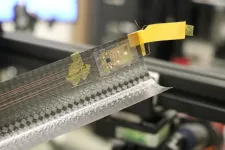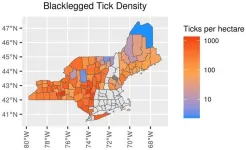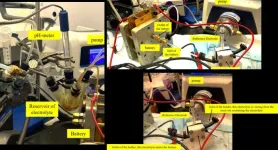(Press-News.org) Being lightweight is essential for space structures, particularly for tools used on already small, lightweight satellites. The ability to perform multiple functions is a bonus. To address these characteristics in a new way, researchers at the University of Illinois Urbana-Champaign successfully integrated flexible electronics with a three-ply, self-deployable boom that weighs only about 20 grams.
“It's difficult to get commercial electronics integrated into these super thin structures,” said Xin Ning, an aerospace professor in The Grainger College of Engineering at U. of I. “There were a lot of engineering constraints adding to the challenge of making the electronics able to withstand the harsh environment of space.”
Ning said the concept for the work began at a conference about two years ago. He presented his unique expertise in making multifunctional space structures that integrate lightweight, flexible electronics.
“It got the attention of Juan Fernandez from NASA Langley Research Center. He was making a boom structure for a Virginia Tech CubeSat project and saw the opportunity to collaborate and add multi-functional devices to the structures instead of just a pure structure,” Ning said.
Ultimately, the boom to contain the electronics was made at NASA Langley Research Center, Ning said. It is a three-ply carbon fiber and epoxy composite material designed to be extremely thin—about as thick as a sheet of paper. It is rolled up like a tape measure with stored energy in its coils until it unfurls on its own in space.
“Virginia Tech had specific requirements for us to follow, some that created challenges,” Ning said. “One was the length. They wanted to have power and data lines over a meter in length embedded in a paper-thin composite material. We tried different materials and different technologies.
“Eventually, we went with thin commercial wires coated with insulation and it worked. I think we were overthinking it at the beginning. We tried more difficult, fancier approaches, but they failed. This was a simple and reliable solution using off-the-shelf, readily available wires.”
Another key component is a lightweight, flexible electronics patch with a motion sensor, a temperature sensor, and a blue LED, all mounted on the boom tip. Ning explained that the electronics needed to endure the harsh thermal-vacuum conditions of space while remaining flexible enough to withstand the sudden unfurling of the coiled boom. The motion sensor monitors the deployment and vibration of the boom, and the blue LED assists CubeSat cameras in seeing the structure in space once deployed.
Ning’s team conducted comprehensive on-ground experiments and simulations to explore the mechanics of the bistable boom with flexible electronics, as well as its deployment and vibration behavior. Ning said that these fundamental studies could offer valuable insights for future designs of multifunctional space structures.
The Virginia Tech three-unit CubeSat with the multifunctional boom is aiming for launch in 2025.
“We are also working on making the flexible electronics more durable in space—ways to protect the electronics so they will be operational longer in the space environment.”
The study, “Multifunctional bistable ultrathin composite booms with flexible electronics,” by Yao Yao and Xin Ning from Illinois, Juan Fernandez from NASA Langley Research Center and Sven Bilén at Penn State is published in Extreme Mechanics Letters. DOI: 10.1016/j.eml.2024.102247
Yao Yao earned a double major in 2018 from Illinois in materials science and engineering and physics. He began working with Xin Ning when he was an undergraduate and Ning was a postdoctoral research associate in materials science at Illinois. Later, Yao joined Ning’s research group when Ning was a professor at Penn State, and now is completing his Ph.D. with Ning back at Illinois again.
END
Flexible electronics integrated with paper-thin structure for use in space
2025-01-16
ELSE PRESS RELEASES FROM THIS DATE:
Immune complex shaves stem cells to protect against cancer
2025-01-16
A group of immune proteins called the inflammasome can help prevent blood stem cells from becoming malignant by removing certain receptors from their surfaces and blocking cancer gene activity, according to a preclinical study by Weill Cornell Medicine investigators.
The study, published Jan. 2 in Nature Immunology, may lead to therapies that target the earliest stages of cancer. The findings bolster the idea that the inflammasome has a dual role—it promotes inflammation associated with poor outcomes in late cancer stages, but early on, it can help prevent cells from becoming cancerous in the first ...
In the Northeast, 50% of adult ticks carry Lyme disease carrying bacteria
2025-01-16
Across most of the Northeast, getting bitten by a blacklegged tick— also called a deer tick — is a risk during spring, summer, and fall. A new Dartmouth study, published in Parasites and Vectors, finds that 50% of adult blacklegged ticks carry the bacteria that causes Lyme disease while 20% to 25% of the younger (nymph) blacklegged ticks carry the bacteria.
A team of researchers from universities, health departments, and agricultural agencies from across the Northeast conducted a meta-analysis of data on how many blacklegged ticks there are and how many of them have the potential to pass pathogens ...
U of A Cancer Center clinical trial advances research in treatment of biliary tract cancers
2025-01-16
TUCSON, Arizona — The results of a clinical trial led by researchers at the University of Arizona Health Sciences and published in the Journal of Clinical Oncology showed that chemotherapy combining three different types of drugs did not improve overall survival for patients with advanced stage, inoperable biliary tract cancers.
“Biliary tract cancer is comparatively rare, but it’s aggressive and spreads fast. Our accrual of more than 450 patients in a little more than two years really shows there is a need for new ways to help people with biliary tract cancer,” ...
Highlighting the dangers of restricting discussions of structural racism
2025-01-16
PHILADELPHIA (January 16, 2025) – A new Health Affairs Health Policy Brief highlights the detrimental impact of recent state and federal policies that restrict discussions of “divisive concepts,” including structural racism. It warns that these policies undermine efforts to address health inequities and improve population health.
“By limiting discussions of structural racism, these policies ignore the historical and environmental factors that shape health outcomes,” said co-author Derek Griffith, PhD, the Risa Lavizzo-Mourey ...
NYU Tandon School of Engineering receives nearly $10 million from National Telecommunications and Information Administration
2025-01-16
NYU Tandon, collaborating institutions and industry partners have been awarded nearly $10 million to develop next generation communications technology.
The project, dubbed SALSA (Spectrally Agile Large-Scale Arrays), is funded by the U.S. Department of Commerce's National Telecommunications and Information Administration (NTIA) to advance U.S. leadership in open, secure communications infrastructure.
SALSA aims to create advanced wireless systems that operate in the "upper mid-band" spectrum — a region of frequencies relatively ...
NASA scientists find new human-caused shifts in global water cycle
2025-01-16
In a recently published paper, NASA scientists use nearly 20 years of observations to show that the global water cycle is shifting in unprecedented ways. The majority of those shifts are driven by activities such as agriculture and could have impacts on ecosystems and water management, especially in certain regions.
“We established with data assimilation that human intervention in the global water cycle is more significant than we thought,” said Sujay Kumar, a research scientist at NASA’s Goddard Space Flight Center in Greenbelt, Maryland, and a co-author ...
This tiny galaxy is answering some big questions
2025-01-16
Leo P, a small galaxy and a distant neighbor of the Milky Way, is lighting the way for astronomers to better understand star formation and how a galaxy grows.
In a study published in the Astrophysical Journal, a team of researchers led by Kristen McQuinn, a scientist at the Space Telescope Science Institute and an associate professor in the Department of Physics and Astronomy at the Rutgers University-New Brunswick School of Arts and Sciences, has reported finding that Leo P “reignited,” reactivating during a significant period on the timeline of the universe, producing stars when many other small galaxies didn’t.
By ...
Large and small galaxies may grow in ways more similar than expected
2025-01-16
A team of astronomers led by University of Arizona researcher Catherine Fielder has obtained the most detailed images of a small galaxy and its surroundings, revealing features typically associated with much larger galaxies. The observations provide a rare, elusive glimpse into how small galaxies form and evolve, suggesting that the mechanisms fueling galaxy growth may be more universal than previously thought.
Fielder presented the findings at the 245th meeting of the American Astronomical Society in National Harbor, Maryland, during a press briefing ...
The ins and outs of quinone carbon capture
2025-01-16
Carbon capture, or the isolation and removal of carbon dioxide from the atmosphere during industrial processes like cement mixing or steel production, is widely regarded as a key component of fighting climate change. Existing carbon capture technologies, such as amine scrubbing, are hard to deploy because they require significant energy to operate and involve corrosive compounds.
As a promising alternative, researchers from the Harvard John A. Paulson School of Engineering and Applied Sciences (SEAS) have developed carbon capture systems that use molecules called ...
Laboratory for Laser Energetics at the University of Rochester launches IFE-STAR ecosystem and workforce development initiatives
2025-01-16
The University of Rochester’s Laboratory for Laser Energetics (LLE) has been awarded a $2.25 million grant over three years from the US Department of Energy’s Office of Fusion Energy Sciences. This funding establishes the Inertial Fusion Energy Science and Technology Accelerated Research (IFE-STAR) ecosystem that brings together academia, national laboratories, and the private sector to develop a clean, safe, and virtually limitless energy source, built on US leadership in inertial fusion.
Inertial ...









